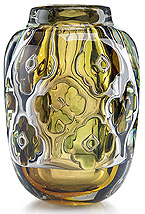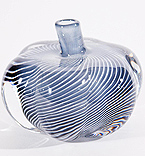







Swedish Glass: The Art of Light
Ivor Hughes looks at the rise in popularity and accessibility of Swedish art glass both domestically and worldwide in the 1950s. During his research he visited Andy McConnell, BBC Antiques Roadshow's glass expert and a dealer widely published on the subject.
Sweden
Sweden is the heart of Scandinavia, most narrowly defined as being just Sweden and most of Norway. More popularly, at least to the rest of the world, the definition also includes Denmark, Finland and Iceland.
Perhaps Sweden's position within Scandinavia is reflected, if not defined, by some of her exports during the second half of the twentieth century: Hasselblad cameras, Saab, Scania and Volvo automotive (Saab also aircraft) and Husqvarna motorcycles and powered tools. All world leaders.
More recently, her ability to design goods and reach bulk markets has been demonstrated by exports such as ABBA, IKEA and Tetrapak. No mean feat as Sweden's costs of living are among the highest in Europe, Which brings us onto Swedish art glass.
Swedish glass
The first commercial glassworks were founded in the sixteenth century, relatively late for Europe. Skilled glassworkers from Italy and Germany were hired by the wealthy nobility for the first glassworks, which were located near the capital of Stockholm; by the late 19th century they were nearly all in the south and central Sweden, especially Smaland which is now known colloquially as Glasriket, or the Kingdom of Crystal (15 of Sweden's 16 glassworks still in operation are in this area).
The Industrial Revolution brought mass production in line with everywhere else. New glassworks were sometimes located in abandoned iron foundries, taking advantage of existing (though redundant) workforces already acclimatised to noise, heat and shift work. This was the case with Orrefors, which was founded in 1898 on the site of an existing ironworks in order to supplement the ironworks income. The first ten years were spent churning out a steady supply of unremarkable and inexpensive tableware and bottles. That all changed in 1913 when new owner Johan Ekman closed the ironworks and reimagined the glass factory in the image of elegance and luxury.
Late 19th century art glass fails
Kosta Glassworks was founded in 1742. One of the world's oldest glassworks still in operation, it now trades as Orrefors Kosta Boda, after merging with Orrefors in 1990. Their website readily admits that their own attempts at art glass displayed at Stockholm World's Exhibition in 1897 were criticised for resembling items made elsewhere. Kosta therefore brought in a new designer, Gunnar Gunnarson Wennerberg, in 1898. Although his Art Nouveau designs were a success, they nonetheless remained Swedish versions of the French.
Swedish industry regroups during WWI
In her scholarly book The Brilliance of Swedish Glass, 1918-1939: An Alliance of Art and Industry, Anne-Marie Ericsson explains how Sweden, remaining neutral, had used the duration of the First World War to refocus. Shortly after, greater emphasis was placed on modernising factories and exploiting new mass production techniques than on traditional arts and crafts. More collaboration was encouraged between artists and manufacturers, the goal being to produce decorative items at a greatly reduced cost.
During this period Orrefors underwent a period of intense development, and at the Paris Exposition of 1925 their designs and craftsmanship were acknowledged with numerous awards. The newly developed Graal glass, made using multiple layers of molten glass to create a three-dimensional effect, was a huge success. At the Stockholm World Fair in 1930, Orrefors designer Vicke Lindstrand presented enamelled vases that were considered to be of cutting edge design. Linstrand, who began his career at Orrefors straight out of art school, would go on to work at Kosta from 1950 to 1973.
Art Deco and Modernism - helping hands
During the inter-war years, and in a market still dominated by France, glass producers in Denmark, Finland, Germany, Holland, Norway and Sweden employed artists and designers who put more thought and effort into simplicity of form and bold use of colour than in decoration and embellishment. That was because many had been trained not in glass, but in architecture, sculpture, fabrics or ceramics.
Sweden quickly gained international recognition as an important producer of art glass at the Paris World Fair of 1925. That was the very exhibition that heralded Art Deco. Swedish minimalist design and the strong geometric lines and bright colours of Art Deco were well suited, but an even closer ally was to be found in Modernism, the art movement typified and publicised by the Bauhaus Art School in nearby Germany.
Swedish and wider Scandinavian design was to receive further recognition and acclaim at international exhibitions such as Stockholm in 1930 and Paris in 1937 - where Finland had her own pavilion. Swedish exhibitors grouped under the title 'Swedish Modern' in New York in 1939, but the prevailing economic depression and political tensions had impeded progress throughout. Post-war austerity was to put things on hold until the 1950s.
Sweden's art glass industry kick-started at home
Sweden emerged a prosperous nation in the early 1950s. As a neutral during the Second World War, her industries had not been damaged or impeded in the same ways as her neighbours'. Her people's income became, and remained, among the highest in Europe. What better way to celebrate that prosperity than to buy the nation's finest art? And art it was. Some of Sweden's glass designs rate among the most recognisable today, including Graal, Kraka, Ravenna and Ariel.
The first Graal pieces were ruby red, and appeared as if a red liquid was flowing freely in the glass. Graal designs are typically soft and blurred, thanks to the reheating and final blowing process. A team of two to four people work in concert with the multiple layers of molten glass to build up the various layers which are then carved, shaped and encased in clear glass. The original technique for Graal glass was used from 1916 until 1936, when Edvard Hald and Vicke Lindstrand experimented to create the 'new' Graal method, with a thicker later of clear glass. Other Graal techniques include Slipgraal, Litograal and Aquagraal, and the Fabula technique pioneered by Per B. Sundberg based on a loose interpretation of the Graal methods.
Kraka glass exhibits a detailed fishnet-like design with the air bubbles trapped in the net. Its name was inspired by the Nordic legend of Kraka, who appeared 'neither dressed, nor undressed'. Most Kraka pieces are vases or bowls and were made using a blue, green and yellowish palette. Pieces where the items are colourless and the metal mesh is worked into the design are rare.
The Ravenna technique was developed by Sven Palmqvist for Orrefors following a trip to Italy, where he became fascinated by the byzantine mosaics. He decided to recreate the designs in glass by placing a coloured glass layer on top of a clear one and then flattening them. The design is created by sandblasting the coloured layer to expose the clear glass. Small air bubbles are sometimes trapped within the glass, which is then reheated. Ravenna pieces are commonly a blue background with a red or rust-coloured design.
To create the Ariel technique, a glass design is cut a minimum of 5mm into a multi-layered blank. When the blank is overlaid with a clear bubble of molten crystal, air is trapped, creating a silvery, reflective effect. Ariel pieces are usually signed with the artist's name and a serial number or date code.
Post-war pieces gathering pace
Ten years ago, the Financial Times interviewed glass dealer, published historian and Antiques Roadshow expert Andy McConnell. He was quoted as saying, "Scandinavian glassware is the most active happening area in antiques." He also predicted "prices will go crazy", and added that there had been a recent escalation in the levels of interest in post-war pieces.
Interest remains keen, though the explosion in values has not happened just yet. Still, who better to ask than Andy McConnell for further insight, particularly while his new book Swedish Glass Design (Antiques Collectors' Club) remains in production?
Glass etc - Antiques and High Class Junk
The name of Andy and Helen McConnell's shop in Rye, on the Sussex Coast, is not only a self-effacing ice-breaker for the timid or uninformed, it also gives recognition to the fact that levels of desirability often rest in the eye of the beholder.
The main part of the shop is full of well-presented collectables, retro and other vintage items: linen, glass, pottery, metal ware, door furniture, kitchenalia, enamelware, tableware - the list goes on.
A side room has several cabinets full of Andy's finer glassware. But thanks to the Swedish ability to produce high quality items in high quantities and at low cost, I certainly didn't spot anything with prices in the stratosphere. For example, the small frosted 'Blue Flower' bowl made by the celebrated artists Göran and Ann Wärff for Kosta in 1965 seemed more than reasonably priced at $75, so it came home with me.
Some of Andy's insight offered on the day? "Finnish glass is the more expensive, due to stronger collector interest. But the Swedes were the best at Modernism, with their stripped-down designs backed by technical excellence. Their approach wasn't purely academic; Swedish art students were sent out to get their hands dirty." Andy is currently finalising his new book's production with Antiques Collectors' Club, date of release not yet confirmed.
This feature first appeared in the Winter 2017 edition of Antiques and Collectables for Pleasure & Profit.